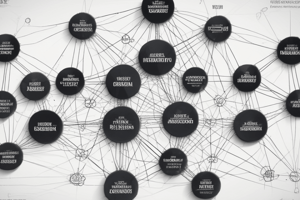Podcast
Questions and Answers
Match the following organizational structure dimensions with their descriptions:
Match the following organizational structure dimensions with their descriptions:
Specialization = The extent to which there are different specialist roles and how they are distributed Standardization = The extent to which an organization uses regularly occurring procedures supported by bureaucratic procedures Formalization = The extent to which written rules, procedures, instructions, and communications are set out for employees Centralization = The extent to which authority to make decisions lies with the top of the organization
Match the following concepts with their descriptions:
Match the following concepts with their descriptions:
Actor-Network Theory (ANT) = Explains the process of creating and maintaining networks for projects, focusing on rationales and concerns. Interessement = Occurrence leads to behavior aligned with desired outcomes by enrolling actors. Mobilization = Successful enrolment creates a network working towards solutions. Institutional Theory = Highlights cultural influences on decisions and stability of organizational arrangements, but not change.
Match the following theories with their emphasis:
Match the following theories with their emphasis:
Institutional Theory = Emphasizes stability, but environmental triggers and technology use impact structure. Chandler's Strategy-Structure thesis = Structure follows strategy due to economic efficiency, but Amburgey and Dacin show a more complex relationship. Isomorphism = Organizations in the same sector adopt similar structures due to conformity, mimesis, and risk aversion. Strategy-Structure relationship = Complex relationship where strategy influences structure more than vice versa.
Match the following outcomes with their causes:
Match the following outcomes with their causes:
Match the following organizational structures with their characteristics:
Match the following organizational structures with their characteristics:
Match the following statements with the appropriate organizational structure:
Match the following statements with the appropriate organizational structure:
Match the following characteristics with the appropriate organizational structure:
Match the following characteristics with the appropriate organizational structure:
Match the following organizational structures with their descriptions:
Match the following organizational structures with their descriptions:
Match the following statements with the concepts they describe:
Match the following statements with the concepts they describe:
Match the following characteristics with their corresponding organizational structures:
Match the following characteristics with their corresponding organizational structures:
Match the following organizational structure concepts with their descriptions:
Match the following organizational structure concepts with their descriptions:
Match the following organizational structure dimensions with their descriptions:
Match the following organizational structure dimensions with their descriptions:
Match the following organizational structure characteristics with their descriptions:
Match the following organizational structure characteristics with their descriptions:
Match the following factors influencing organizational structure with their descriptions:
Match the following factors influencing organizational structure with their descriptions:
Match the organizational forces with their corresponding descriptions:
Match the organizational forces with their corresponding descriptions:
Match the organizational forms with their characteristics:
Match the organizational forms with their characteristics:
Match the organizational influences on structure with their descriptions:
Match the organizational influences on structure with their descriptions:
Flashcards are hidden until you start studying
Study Notes
- Mintzberg's "forces" and "forms" and their roles in strategy and organization.
- Seven forces driving organizations: direction, efficiency, proficiency, concentration, innovation, cooperation, and competition.
- Forces for direction and efficiency: strategic vision, balancing costs and benefits, encourages standardization and formalization.
- Forces for proficiency, concentration, innovation: high levels of knowledge and skills, serving particular markets, searching for new products or services.
- Forces for cooperation and competition: pulling together ideology and culture, pulling apart policies and non-legitimate behavior.
- Mintzberg's "organizational forms": entrepreneurial, machine, professional, adhocracy, and diverse.
- Entrepreneurial form: low formalization and standardization, high centralization, authority located in a single person.
- Machine form: high formalization and standardization, centralized authority vested in rules and regulations, functional departments.
- Professional form: high complexity and formalization, low centralization, trained specialists for core work.
- Adhocracy form: very low standardization and formalization, little hierarchy, much use of temporary project teams.
- Diverse form: a combination of functions and products, with products dominating.
- Other influences on structure: size, technology, and informational technology.
- Size: positively correlated to overall role specialization and formalization of procedures.
- Technology: influences organizational structure and production systems.
- Informational technology: gives managers the ability to push information closer to the point of use, increases responsibility on employees, supports decentralization and matrix structures, and reduces hierarchy.
- External and environmental influences: the choice of organizational structure depends on the capacity, stability, and complexity of the environment.
- Socio-cultural influences: employees' desire for more flexible ways of organizing their work-life balance.
Studying That Suits You
Use AI to generate personalized quizzes and flashcards to suit your learning preferences.




